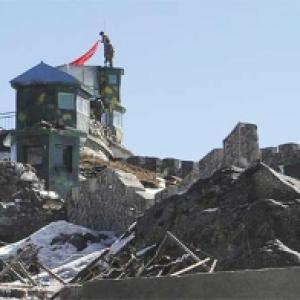The uproar over 'dams' following the Uttarakhand disaster is ill-informed & potentially counter-productive, says Anand Sankar
 The environmentalist lobby has been predictably up in arms in the aftermath of the Uttarakhand flash floods. "Dams" have been blamed unequivocally for all the ills that have currently befallen the region. This is a scenario in which the environmental lobby gets plenty of media airtime. But as always, instead of using this as an opportunity to bring reason and clarity into the picture, there has been a lot of demand to ban "dams" in Uttarakhand.
The environmentalist lobby has been predictably up in arms in the aftermath of the Uttarakhand flash floods. "Dams" have been blamed unequivocally for all the ills that have currently befallen the region. This is a scenario in which the environmental lobby gets plenty of media airtime. But as always, instead of using this as an opportunity to bring reason and clarity into the picture, there has been a lot of demand to ban "dams" in Uttarakhand.
This is the kind of situation where the environmental lobby loses its fight instead of gaining an upper hand in enacting better laws and better enforcement of regulations. In this case, it is first fundamentally wrong in using the word "dam" generically, which is why I am using the word in quotes.
Second, while the Tehri dam in Uttarakhand is being blamed for all problems, it is the truth that the dam has saved the towns of Devprayag and Rishikesh from worse damage. Tehri was at its lowest storage level after the summer when the flash floods struck the Bhagirathi. Thus, it had enough capacity to absorb the initial gush of floodwater and release it in a controlled manner downstream. It would have been truly disastrous had the Bhagirathi and Alaknanda combined in spate at Devprayag, it could have even led to serious damage in the plains of western Uttar Pradesh. Refusal to acknowledge this is a stunning failure of the environmental lobby.
Read on further and you will understand...
I spent a good part of my career as a journalist covering the hydroelectric projects coming up in the Himalayan region right from Kashmir to Arunachal Pradesh. During the course of this, I have interacted with some eminent environmental activists as well as some of India's finest civil engineers involved in the construction of hydroelectric projects in the region. My writing has often been criticised as being anti-development. But I have never been "anti-dam". Where I have been severe is the lack of enforcement of some excellently written regulations.
To even begin comprehending this issue of "dams", you need to first get to grips with the basics of hydroelectricity. We all know hydroelectricity is converting the potential/kinetic energy of stored/flowing water. From this definition, you can now guess that there are two methods of generating electricity from water. The first one is building large dams across rivers, which store humongous amounts of water and it is used for electricity -- this is where the usage of "dams" ends. The second method is what is called Run Of The River hydroelectric projects. These, instead of storing water, harness directly energy from the flow of water. ROTR projects are not dams.
The history of dams includes examples such as the Hoover Dam (the US), Three Gorges Dam (China), Bhakra Nangal (on the Himachal-Punjab border) and Tehri in Uttarakhand. The story of these large projects has been chequered -- with benefits and pitfalls that have been well documented. By and large, these projects have delivered what they have promised but at a huge economic and social cost.
These projects are largely falling out of favour due to cost and new research that show pitfalls such as greenhouse gas emissions from rotting submerged vegetation and earthquake risks. But the final nail in their coffin has been social costs of relocating people whose homes and livelihoods are submerged by the water storage. There are very few large dams in planning around the world, they are mostly in places where the social costs are minimal, and environmental and regulatory safeguards lax. We in India currently have one large dam under construction, Subansiri Dam in Arunachal Pradesh, and a larger one, Dibang, is under litigation.
The ROTR projects draw on the basics of how electricity was first generated from water -- building powerhouses on the banks of rivers. ROTR projects take it a step further by using modern turbines to extract electricity with the most efficiency. True to its name the ROTR projects let the river flow and don't totally impede it like a dam. But along its course diversion tunnels - a few hundred metres or even a couple of kilometres long -- are created through which water is forced to feed the generation turbines. The tunnels are blasted into the hillsides.
Do ROTR projects need water storage? Yes, a small amount. Just past the tunnel entrances, a barrier is put up on the riverbed to create a "head" of storage. This "head" is created so that the turbines never run dry, which can destroy them, and the project continues to generate electricity in the lean season -- late winter and early summer in the Himalayas. A hydroelectric project is only viable as a business if it can produce power throughout the year and increase or decrease generation according to demand. But this storage "head" by law is required to let some water flow into the river to keep its natural ecosystem intact.
ROTR projects today can generate as much electricity as a dam but with a much smaller footprint. All the planned projects in Uttarakhand and in other parts of the Himalayas are ROTR projects. These projects have an advantage that they don't interfere much with natural silt movement downriver.
So, why are the hydroelectric projects that have been executed and under construction in the Himalayan region getting bad press? The story is the same as with anything from mining to urban planning in India. The water resources sector is, in fact, better off since we have some very far-sighted laws and regulations laid down. But we have miserably failed in enforcing them in the last two decades. This period has been described as a "gold rush" for hydroelectric projects in India.
With the sector opened up for private participation, new virgin areas to work in and availability of credit meant that everybody and his mother started bidding for power projects. Companies with no history of working in power generation bid and won projects. Coupled with the politician-industrialist nexus, it meant projects were signed with highly favourable terms and a guarantee to keep enforcement of regulations to a minimum or, worse, turn a blind eye.
There is ample evidence of water flow data and data of silt percentage in the water during summer and the monsoons being fudged to sanction projects in areas where they should not have been sanctioned. At construction sites, engineering norms were flouted -- by both an intention to save cost and a lack of expertise -- when it came to building roads to sites, designing the tunnels and stabilising the hillsides.
Clearly-laid pollution control norms to dispose of construction rubble were flouted. Where afforestation was required to compensate for tree felling, terms were written to do the needful hundreds of kilometres away, instead of locally. Enough water has not been left to flow in the riverbed to maximise power generation.
The saddest aspect of this fiasco has been state-owned companies who must set an example by following norms strictly but went about flouting them, setting a neat precedent for the private sector. The state-owned companies are de-facto controlled by private construction contractor lobbies. Executed projects missing generation targets and facing severe downtime due to high silt levels in the water is enough evidence to nail the malpractice that has occurred.
It is urgent that commissioned projects are independently assessed and mitigation measures framed to lessen their negative impacts. Further, some new projects might need to be modified or cancelled. When executed properly, hydroelectricity, especially ROTR projects, are the cleanest form of energy that can be produced currently with the least footprint. This shrill debate must not lead to policy paralysis or worse a "people's movement" which would cause more harm than good. We are a severely power deficient nation and that deficiency, if not addressed, would only breed energy inefficiency. Don't hold technology hostage; it's people who should be held accountable.
The author is a journalist and travel entrepreneur based in Dehradun











